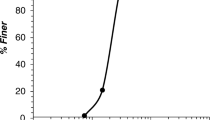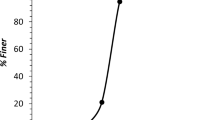Abstract
The slag and waste tires are among the major wastes associated with the mining and automobile sectors, respectively. The disposal of such large quantities of waste requires immediate attention. This manuscript focusses on the application of copper slag under unreinforced and reinforced conditions as a load-bearing filling material in shallow foundations. For this purpose, model footing tests were conducted on copper slag under central and eccentric-inclined loading. The locally available sand was used as a reference. The parameters studied included the placement density, type of loading, tire chip content, and depth of reinforced zone. The pressure settlement behaviour of the copper slag was superior to local sand under central vertical as well as under eccentric inclined loading conditions. Quantitively, the bearing capacity increased by up to 21 times, when compared to the locally available sand. Furthermore, when mixed with tire chips, the bearing capacity of the copper slag increased by up to 1.41 times to that of the unreinforced case. The leaching potential of the copper slag was evaluated using toxicity characteristic leaching procedure tests. It was observed that the concentrations of the leached elements were well below the regulatory limits prescribed by the US, EPA. Henceforth, it can be concluded that the use of copper slag as a load-bearing filling material not only prevents the disposal of this waste into valuable land but also works as a sustainable alternative to prevalent ground improvement methods.
Similar content being viewed by others
References
Al-Bared MAM, Harahap ISH, Marto A (2018a) Sustainable strength improvement of soft clay stabilized with two sizes of recycled additive. International Journal of GEOMATE 15(51):39–46
Al-Bared MAM, Harahap ISH, Marto A, Alavi Nezhad Khalil Abad SV, Mustaffa Z, Ali MOA (2019a) Undrained shear strength and microstructural characterization of treated soft soil with recycled materials. Geomecchanics and Engineering 18(4):427–437, DOI: https://doi.org/10.12989/gae.2019.18.4.427
Al-Bared MAM, Harahap ISH, Marto A, Alavi Nezhad Khalil Abad SV, Mustaffa Z, Ali MOA (2019b) Mechanical behaviour of waste powdered tiles and Portland cement treated soft clay. Geomechechanics and Engineering 19(1):37–47, DOI: https://doi.org/10.12989/gae.2019.19.1.037
Al-Bared MAM, Marto A, Latifi N (2018b) Utilization of recycled tiles and tyres in stabilization of soils and production of construction materials — A state-of-the-art review. KSCE Journal of Civil Engineering 22(10):3860–3874, DOI: https://doi.org/10.1007/s12205-018-1532-2
Al-Bared MAM, Marto A, Latifi N, Horpibulsuk S (2018c). Sustainable improvement of marine clay using recycled blended tiles. Geotechnical and Geological Engineering 36:3135–3147, DOI: https://doi.org/10.1007/s10706-018-0525-8
Al-Jabri KS, Hisada M, Al-Saidy AH, Al-Oraimi SK (2009) Performance of high strength concrete made with copper slag as a fine aggregate. Construction and Building Materials 23(6):2132–2140, DOI: https://doi.org/10.1016/j.conbuildmat.2008.12.013
Al-Jabri KS, Taha RA, Al-Hashmi A, Al-Harthy AS (2006) Effect of copper slag and cement by-pass dust addition on mechanical properties of concrete. Construction and Building Materials 20(5):322–331, DOI: https://doi.org/10.1016/j.conbuildmat.2005.01.020
Anbazhagan P, Manohar DR, Rohit D (2017) Influence of size of granulated rubber and tire chips on the shear strength characteristics of sand — Rubber mix. Geomechanics and Geoengineering 12(4):266–278, DOI: https://doi.org/10.1080/17486025.2016.1222454
ASTM D2487 (2017) Standard practice for classification of soils for engineering purposes (Unified Soil Classification System). ASTM D2487, ASTM International, West Conshohocken, PA, USA
Australasian Slag Association (2014) Quick reference guide 1 — Road guide supplement on general applications. Australasian Slag Association, Wollongong, Australia
Balunaini U, Yoon S, Prezzi M, Salgado R (2014) Pullout response of uniaxial geogrid in tire shred-sand mixtures. Geotechnical and Geological Engineering 32(2):505–523, DOI: https://doi.org/10.1007/s10706-014-9731-1
Behnood A, Modiri Gharehveran M, Gozali Asl F, Ameri M (2015). Effects of copper slag and recycled concrete aggregate on the properties of CIR mixes with bitumen emulsion, rice husk ash, Portland cement and fly ash. Construction and Building Materials 96:172–180, DOI: https://doi.org/10.1016/j.conbuildmat.2015.08.021
Bravo M, Brito J (2012) Concrete made with used tire aggregate: Durability-related performance. Journal of Cleaner Production 25(2012):42–50, DOI: https://doi.org/10.1016/j.jclepro.2011.11.066
Cardoso R Silva RV, Brito JD, Dhir R (2016). Use ofrecycled aggregates from construction and demolition waste in geotechnical applications: A literature review. Waste Management 49:131–145
Das BM, Tarquin AJ, Jones AD (1993) Geotechnical properties of a copper slag. Transportation Research Record 941(3):1–4
Dhir RK, Brito J, de Mangabhai R, Lye CQ (2017) Sustainable construction materials: Copper slag (2nd edition). Elsevier, Amsterdam, The Netherlands
Edwin RS, de Schepper M, Gruyaert E, de Belie N (2016). Effect of secondary copper slag as cementitious material in ultra-highperformance mortar. Construction and Building Materials 119:31–44, DOI: https://doi.org/10.1016/j.conbuildmat.2016.05.007
Edwin RS, Gruyaert E, de Belie N (2017). Influence of intensive vacuum mixing and heat treatment on compressive strength and microstructure of reactive powder concrete incorporating secondary copper slag as supplementary cementitious material. Construction and Building Materials 155:400–412, DOI: https://doi.org/10.1016/j.conbuildmat.2017.08.036
Elci H (2016). Utilisation of crushed floor and wall tile wastes as aggregate in concrete production. Journal of Cleaner Production 112:742–752, DOI: https://doi.org/10.1016/j.jclepro.2015.07.003
Gill G, Mittal RK (2019). Use of waste tire-chips in shallow footings subjected to eccentric loading — An experimental study. Construction and Building Materials 199:335–348, DOI: https://doi.org/10.1016/j.conbuildmat.2018.12.024
Gorai B, Jana RK, Premchand (2003) Characteristics and utilization of copper slag — A review. Resources, Conservation and Recycling 39(4):299–313, DOI: https://doi.org/10.1016/S0921-3449(02)00171-4
Hataf N, Rahimi MM (2006) Experimental investigation of bearing capacity of sand reinforced with randomly distributed tire shreds. Construction and Building Materials 20(10):910–916, DOI: https://doi.org/10.1016/j.conbuildmat.2005.06.019
Havanagi VG, Prasad PS, Guruvittal UK, Mathur S (2006). Feasibility of utilization of copper slag-fly as-soil mixes for road construction. Highway Research Bulletin 75:59–75
Havanagi VG, Singa AK, Prasad PS, Sitaramanjaneyulu ME, Mathur S (2009) Copper slag as an alternative material for road construction. In: Proceedings of the 24th international conference on solid waste technology and management, March 15–19, Philadelphia, PA, USA, 133–144
Havanagi VG, Sinha AK, Arora VK, Mathur S (2012) Waste materials lor construction ofroad embankment and pavement layers. International Journal of Environmental Engineering Research 1(2):51–59
Hazarika H (2006) Model shaking table test on seismic performance of caisson quay wall reinforced with protective cushion. In: Proceedings of international society of offshore and polar engineers, May 28–June 2, San Francisco, CA, USA, 309–315
IS:2720-3 (1) (1980) Methods oftest for soils — Determination of specific gravity. IS: 2720-3 (1), Bureau of Indian Standards, New Delhi, India
IS:2720-4 (1985) Methods of test for soils — Rain size analysis. IS:2720-4, Bureau of Indian Standards, New Delhi, India
IS:2720-13 (1986) Methods of test for soils — Direct shear test. IS:2720-13, Bureau of Indian Standards, New Delhi, India
IS:2720-14 (1983) Methods of test for soils — Determination of density index for cohesionless soils. IS: 2720-14, Bureau of Indian Standards, New Delhi, India
Ladd RS (1978) Preparing test specimens using undercompaetion. Geotechnical Testing Journal 1(1):16–23, DOI: https://doi.org/10.1520/GTJ10364J
Lavanya C, Rao AS, Kumar ND (2012) Influence of admixture on shear parameters of copper slag. IJERT 1(10):1–6
Lavanya C, Rao AS, Kumar ND (2013) Study on coefficient of permeability of copper slag when admixed with lime and cement. IOSR-JMCE 7(6):19–25
Lim TT, Chu J (2006). Assessment of the use of spent copper slag for land reclamation. Waste Management and Research 24:67–73, DOI:https://doi.org/10.1177/0734242X06061769
Ma Q, Du H, Zhou X, He K, Lin Z, Yan F, Guo R (2018). Performance ofcopper slag contained mortars after exposure to elevated temperatures. Construction and Building Materials 172:378–386, DOI: https://doi.org/10.1016/j.conbuildmat.2018.03.261
Mittal RK, Gill G (2018). Sustainable application of waste tire chips and geogrid for improving load carrying capacity of granular soils. Journal of Cleaner Production 200:542–551, DOI: https://doi.org/10.1016/j.jclepro.2018.07.287
Mittal RK, Gill G (2020) Pressure settlement behaviour of strip footing resting on tire chip reinforced sand. International Journal of Geotechnical Engineering 14(2):162–168
Moghaddas Tafreshi SN, Joz Darabi N, Tavakoli Mehrjardi G, Dawson A (2019) Experimental and numerical investigation of footing behaviour on multi-layered rubber-reinforced soil. European Journal of Environmental and Civil Engineering 23(1):29–52, DOI: https://doi.org/10.1080/19648189.2016.1262288
Moghaddas Tafreshi SN, Norouzi AH (2012) Bearing capacity of a square model footing on sand reinforced with shredded tire — An experimental investigation. Construction and Building Materials 35(2012):547–556, DOI: https://doi.org/10.1016/j.conbuildmat.2012.04.092
Moo-Young H, Sellasie K, Zeroka D, Sabnis G (2003) Physical and chemical properties of recycled tire shreds for use in construction. Journal of Environmental Engineering 129(10):921–929, DOI:https://doi.org/10.1061/(ASCE)0733-9372(2003)129:10(921)
Murty AVSR (1967) Bearing capacity of footings under inclined loads. M. E. Thesis, University of Roorkee, Roorkee, India
Najimi M, Sobhani J, Pourkhorshidi AR (2011) Durability of copper slag contained concrete exposed to sulfate attack. Construction and Building Materials 25(4):1895–1905, DOI: https://doi.org/10.1016/j.conbuildmat.2010.11.067
National Slag Association (2005) Once again slag proves “Less is More” on Michigan’s M-63 in Benton Harbour. National Slag Association, West Lawn, PA, USA
Nippon Slag Association (2003) Iron and steel slag products: Civil engineering works and ports/harbours. Nippon Slag Association, Tokyo, Japan
Patel S, Shahu JT, Senapati A (2011) Feasibility of copper slag — Fly ash mix as a road construction material. In: Proceedings of the 2nd international conference on advances in civil engineering, November 16–19, Noida, India
Patel S, Vakharia PP, Raval SM (2007). Use of copper slag and fly ash mix as subgrade and embankment fill material. Journal of Indian Highway 11:17–22
Prasad PS, Ramana GV (2016). Feasibility study ofcopper slag as a structural fill in reinforced soil structures. Geotextiles and Geomembranes 44:623–640, DOI: https://doi.org/10.1016/j.geotexmem.2016.03.007
Raj S, Rai AK, Havanagi VG (2018) Suitability of stabilized copper slag and fly ash mix for road construction. World Journal of Engineering 15(3):336–344, DOI: https://doi.org/10.1108/WJE-08-2017-0220
Raposeiras AC, Vargas-Cerón A, Movilla-Quesada D, Castro-Fresno D (2016). Effect of copper slag addition on mechanical behavior of asphalt mixes containing reclaimed asphalt pavement. Construction and Building Materials 119:268–276, DOI: https://doi.org/10.1016/j.conbuildmat.2016.05.081
Reddy SB, Kumar DP, Krishna AM (2016) Evaluation of the optimum mixing ratio of a sand-tire chips mixture for geoengineering applications. Journal of Materials in Civil Engineering 28(2):1–7
Saran S, Kumar S, Garg K, Kumar A (2008) Model tests on eccentrically and obliquely loaded footings resting on reinforced sand. International Journal of Geotechnical Engineering 2(3):179–197, DOI: https://doi.org/10.3328/IJGE.2008.02.03.179-197
Sawwaf M El, Nazir A (2012) Behavior of eccentrically loaded small-scale ring footings resting on reinforced layered soil. Journal of Geotechnical and Geoenvironmental Engineering 138(3):376–384, DOI: https://doi.org/10.1061/(ASCE)GT.1943-5606.0000593
Sharma R, Khan RA (2017). Durability assessment of self-compacting concrete incorporating copper slag as fine aggregates. Construction and Building Materials 155:617–629, DOI: https://doi.org/10.1016/j.conbuildmat.2017.08.074
Silva RV, de Brito J, Dhir RK (2014). Properties and composition of recycled aggregates from construction and demolition waste suitable for concrete production. Construction and Building Materials 65:201–217
Singh S, Nagar R, Agarwal V (2016). A review on Properties of Sustainable Concrete using granite dust as replacement for river sand. Journal of Cleaner Production 126:74–87, DOI: https://doi.org/10.1016/j.jclepro.2016.03.114
US EPA SW-846 (2004) Test methods for evaluating solid waste physical/chemical methods, chapter 7, 5. US EPA SW-846, US EPA, Washington DC, USA
US EPA Test Method 1311 (1992) Toxicity characteristic leaching procedure. US EPA Test Method 1311, US EPA, Washington DC, USA
Yadav JS, Tiwari SK (2019) The impact of end-of-life tires on the mechanical properties of fine-grained soil: A review. Environment, Development and Sustainability 21(2):485–568, DOI: https://doi.org/10.1007/s10668-017-0054-2
Zainuddin N, Yunus NZM, Al-Bared MAM, Marto A, Harahap ISH, Rashid ASA (2019). Measuring the engineering properties of marine clay treated with disposed granite waste. Measurement 131:50–60, DOI: https://doi.org/10.1016/j.measurement.2018.08.053
Author information
Authors and Affiliations
Corresponding author
Rights and permissions
About this article
Cite this article
Gill, G., Mittal, R.K. & Dandautiya, R. Pressure Settlement Behaviour of Strip Footing Resting on Unreinforced and Tire Chips Reinforced Copper Slag. KSCE J Civ Eng 25, 92–106 (2021). https://doi.org/10.1007/s12205-020-0606-0
Received:
Revised:
Accepted:
Published:
Issue Date:
DOI: https://doi.org/10.1007/s12205-020-0606-0




